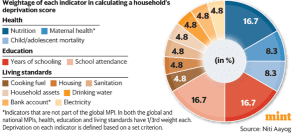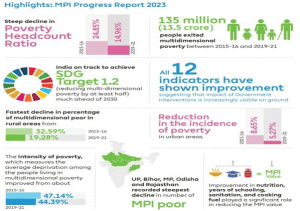NITI AAYOG ‘POVERTY’ STATS: SERIOUS THEORETICAL, METHODOLOGICAL, EMPIRICAL QUESTIONS
THE CONTEXT: The NITI Aayog and UNDP’s report on the Multidimensional Poverty Index raises critical discussions on poverty measurement in India. Government claims of poverty reduction contradict scholarly critiques on the validity of data considering the COVID-19 pandemic impact. This debate underscores an urgent need for transparent, accurate socioeconomic statistics to inform equitable policymaking.
ISSUES:
- The Reliability of Multidimensional Poverty Index (MPI) Data: There is a concern about the accuracy of the statistical methods and the credibility of the MPI data, especially given the contrast with the economic slowdown and the impact of the COVID-19 pandemic. Existence of unresolved theoretical and methodological questions concerning the measurement of multidimensional poverty.
- Projection Beyond Survey Data: Use of NFHS data for a limited period to project trends beyond the actual survey years raise questions about the validity of such forward projections.
- Disproportionate Economic Impact of the COVID-19 Pandemic on Poverty: Evidence suggests that lower-income groups experienced greater income losses during the pandemic, thus potentially increasing multidimensional poverty. Differential impact on income levels across various percentiles, with the poorest experiencing significant income drops.
- Non-monetary Deprivations: The pandemic exacerbated difficulties accessing essential services like education and healthcare, likely increasing multidimensional poverty. Increasing non-monetary educational, healthcare, and nutrition deprivations points to a rise in absolute and relative poverty measures.
- Challenges in Poverty Statistics: The suspension of consumption expenditure surveys since 2014 has led to a lack of updated and reliable data for accurate poverty measurement. There is a need for critical scrutiny of poverty and welfare statistics to avoid misleading conclusions.
- Political and Ideological Overtones in Poverty Measurement: There are accusations that the MPI data is being used to support a government narrative of successful poverty reduction rather than presenting an objective reality.
- Development Indices’ Limitations: Limitations are inherent in the chosen indicators and metrics used to construct development indices.
- Utility versus Deprivation Perspectives: The inadequacy of growth as a sole indicator of quality of life and the imperative for considering utility and deprivation in evaluating poverty. Poverty is a broader concept reflecting powerlessness and lack of opportunity rather than mere income levels.
THE WAY FORWARD:
- Revival and Improvement of Statistical Mechanisms: The government should prioritize reviving the consumption expenditure survey and regularly updating the census data to provide a reliable foundation for poverty assessment.
- Transparent Data Sharing and Accessibility: An institutional framework ensuring transparency and public accessibility of raw data can be effective. This would facilitate cross-verification and independent analysis, enhancing the conclusions’ credibility.
- Inclusion of Pandemic Impact in Data Modelling: Given the adverse economic impacts of the COVID-19 pandemic, new models should be developed to capture the multidimensional aspects of poverty that account for this shock.
- Multi-disciplinary Approach to Poverty: Addressing poverty requires understanding its multifaceted nature, involving economists, sociologists, public health experts, and other relevant professionals to encompass all dimensions of poverty.
- Policy Responsiveness: Design policies responsive to the ground realities captured through robust data and ensure that welfare programs are readjusted based on empirical evidence of their impact.
- Multipronged Poverty Assessment: There should be an incorporation of diverse methods for poverty assessment beyond income/expenditure, including indices that reflect real access to services and opportunities and acknowledge non-monetary deprivations.
- Expanding Social Protection Measures: The government should re-examine and expand social protection measures to shield the most vulnerable from economic shocks, such as those experienced during the pandemic.
THE CONCLUSION
The robust debate around the Multidimensional Poverty Index highlights the vital need for transparent, empirical data to shape effective policy. Addressing poverty in India with accurate metrics is crucial for directing welfare measures where they are most needed. Through this lens of critical evaluation and non-partisan methodology, future policies must be crafted to address the multifaceted nature of poverty truly.
UPSC PREVIOUS YEAR QUESTION
Q. Though there have been several different estimates of poverty in India, all indicate reduction in poverty levels over time. Do you agree? Critically examine with reference to urban and rural poverty indicators. (2015)
MAINS PRACTICE QUESTION
Q. Discuss the challenges and implications of using the Multidimensional Poverty Index (MPI) to measure poverty in India, considering the conflicting narratives and political influence on poverty statistics. What steps should be taken to ensure a depoliticized and analytically coherent discourse on poverty and social policy in the country? Explain.

